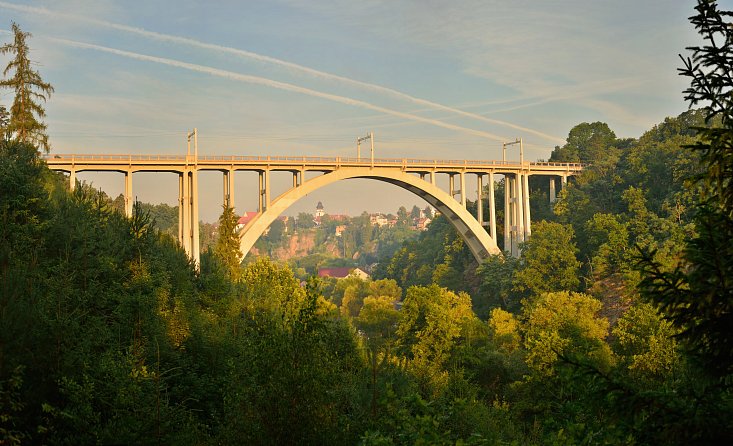
At the beginning of the 20th century Bechyně was connected with Tábor by the railway but the terminal station was on the left bank of the Lužnice river. Since the twenties the need of the connection of both banks of the river had become more and more urgent because the old bridge in the village of Zářečí with two-metre wide road and a bearing capacity of thirty quitals had not complied with the increasing transport and industrial requirments.
As early as 1922, the administrative committee in Bechyně considered the possibility of building a new bridge and in the end it came to the conclusion that the new bridge would be built in the narrowest place of the Lužnice valley between the terminal railway station and the town. It was Dr. Ing. Eduard Viktora who on 11th September 1924 was charged with the task of designing the new bridge with the prolonged electric railway into the town. It was A.Kovář who was the chairman of the district administrative committee in Bechyně at the beginning of the construction when a 50% state subsidy was gained. He thought the construction to be the best example of the town`s self-goverment. Other members of the district administrative committee were: F.Marek, F.Kyrian, J.Dlouhý, J.Studenovský, M.Bílek, K.Plaňanský. On 15th November 1925 the Ministry of public works assigned the construction to the Hlava and Dr. Kratochvíl firm. It was to be done according to Eduard Victora`s design. The district administrative committee became the building contractor, Ing. K.Šiška, the councillor of the ministry of public works, was the main supervisor of the construction. The implementation of the designed construction became a good opportunity to show the high standard and skill of Czech technicians and craftsmen. Dr. Ing. Janák, the Ministry of Railways, and J.Jakš, Ministry of Finance advisor, gained recognition for speeding up the construction.
About four hundred people were employed on the construction site, among them being fourteen fitters and mechanics, seventeen blacksmiths and locksmiths, fifty-six carpenters and wheelwrights, thirty concrete layers and bricklayers. The rest of the workers were made up of various occupations. The speedy and fluent development of the construction has been admired to the present day. The construction was assigned at the end of 1925. The preparatory works started in May 1926, the arch belts together with the reinforced braces were fixed with concrete at the beginning of December 1926, other concreting works were carried out approximately by the end of 1927 and the construction was completed in the summer of 1928. The bridge was opened in a festive way on 28th October 1928 to commemorate the tenth anniversary of the Republic. At the same time the railway was prolonged to the new railway station and the new approach to the Opařany road was built.
About 2200 m3 of timber for segments and planking, 2500 tons of cement and 500 tons of iron were necessary for the construction. For the concrete, sand from the river Lužnice and gravel from the stone pit Čermák were used. In the course of the construction nobody lost his life and was seriously injured. The dimensions of the bridge: The bridge consists of the main arch field and side viaducts. The main field is spanned with two arch belts connected by reinforced braces. The span of the arch is 90 m, the raise is 38 m. The distance between the arch belts at the top is 6m, in the belt 8,25 m. The span af the adjacent fields is 13,5 m, the top height of the columns is 28 m. The bridge construction is ferroconcrete. The height of the bridge from the river level is 50 m, the lenghth of the bridge is 203,38 m. The total costs of five million Czech crowns was divided among the Republic (Czechoslovakia - 50%), the land (Bohemia - 20%) and the town of Bechyně - 30%.
In 1983 the town museum of Bechyně arranged an exhibition about the construction of the bridge in Bechyně. The general public could see a number of photographs and documents showing the remarkable achievement of that time. The municipal office of Bechyně owns a 32 mm documentary film about the construction of the bridge. The daring arch of the bridge spanning over the deep valley of the river Lužnice has received the name THE BECHYNĚ RAINBOW in the course of years.